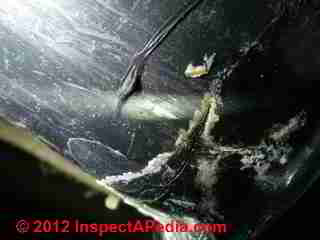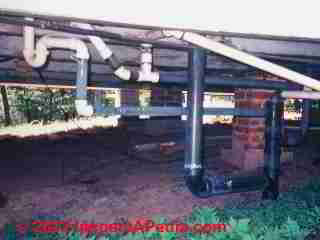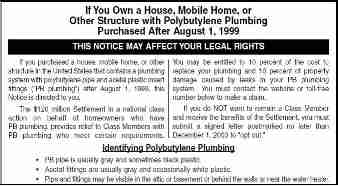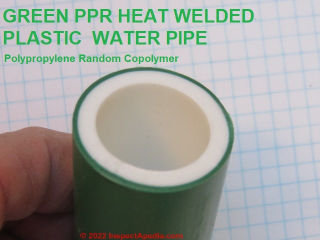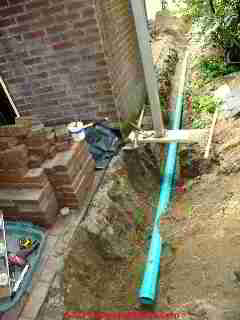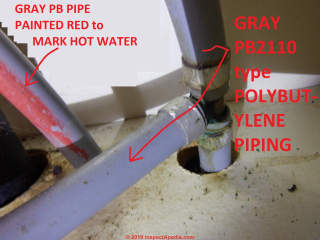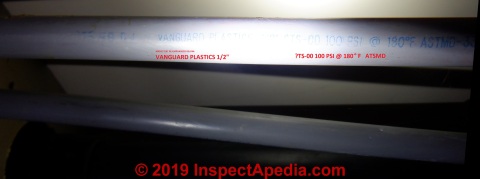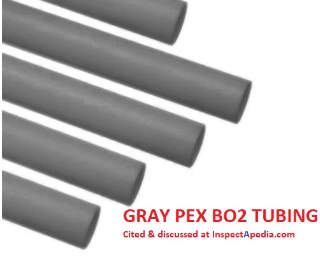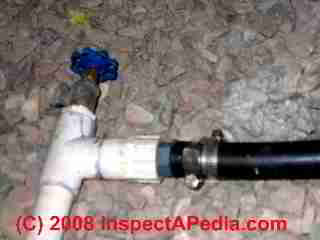 Plastic Piping Types
Plastic Piping Types
Identify, Inspect & Test Plastic Plumbing Piping & Connectors
Properties, Failures, & Standards for
ABS CPVC PB PEX PVC
Piping
- POST a QUESTION or COMMENT about plastic supply and drain piping, gas piping, etc.
Plastic plumbing pipes:
Beginning here, this article series describes the properties of all types of plastic piping and tubing used in buildings for water supply, drainage, or gas or oil fuels, including ABS, CPVC, PB, PEX, PVC.
We include information about failures and problems with some generations of plastic pipes (ABS, polybutylene) and we describe good building practice installation details where plastic piping is being installed.
InspectAPedia tolerates no conflicts of interest. We have no relationship with advertisers, products, or services discussed at this website.
- Daniel Friedman, Publisher/Editor/Author - See WHO ARE WE?
Plastic Water Supply & Drain Piping Types, Failures, Inspection, Diagnosis, Repair
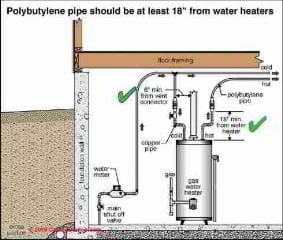
This is a starting point for finding out how to identify, inspect, or obtain & use various types of plastic pipes in building plumbing, heating, & air conditioning systems. Along with some identification photos and notes on how to recognize different types of plastic pipe used in buildings we link to articles offering in-depth information about each of those.
Included here and in this article series is information about ABS, PB, Polybutylene, PEX, PVC polyvinyl chloride and other plastic piping materials. We discuss problems and class action claims for plastic pipe product failures including both the piping itself and its connectors or fittings for each of these materials where trouble has been found.
We also discuss ongoing or previous health & safety concerns raised for some plastic piping products. The articles at this website will answer most questions about plastic building water supply and building drain piping products, failures, and claims as well as many other building plumbing system inspection or defect topics.
[Click to enlarge any image]
As Carson Dunlop Associates point out in the Home Reference Book, as currently used in buildings:
Types of Plastic water service piping
Plastic water piping may be made of different constituents with different properties and different uses listed here:
- PolyButylene (PB)
- PolyEthylene (PE) - PEX including High Density Polyethylene (HDPE) and Low Density Polyethylene (LDPE) and Linear Low Density Polyethylene (LLDPE)
- Cross-linked polyethylene- (PEX)
- PolyVinyl Chloride (PVC) - essentially CPVC
- Polypropylene Random Copolymer (PPR) - heat-welded UV-resistant, described below on this page.
- Chlorinated Polyvinyl Chloride - (CPVC)
LDPE is suitable for use at lower pressures (below 45 psi or below 3 bar) whhile HDPE pipe may be used at highre pressures (45-175 psi or 3-12 bar). The structure of these two plastic famiies differes: HDPE plastics are crystalline in structure while LDPE is not, so HDPE is also a more-dense plastic. HDPE is a stronger material and more resilient than LDPE, but both LDPE and HDPE have suitable uses.
LDPE pipe is a bit more flexible than HDPE - useful in some applications. Both are similarly weatherproof, light-weight, and resistant to chemicals and to abrasion. (HDPE is a bit more abrasion resistant.)
More details about each of these plastics are given below.
Plastic building drain piping
Plastic drain pipes are typically be made of
- ABS- Acrylonitrile Butadiene Styrene (ABS) Plastic
- LDPE - low density polyethylne (in some countries and markets LDPE is replacing PVC for certain drain pipe applications such as wastwater treatment).
- PVC - PolyVinyl Chloride pipe and pipe fittings (white plastic)
- PB - PolyButylene pipe and acetal plastic insert pipes - "PB plumbing"
- PP - Polypropylene plastic
Most plastic piping used outdoors is buried at least 18 inches deep. Exposed piping may be subject to mechanical damage and deterioration from sunlight.
Plastic supply piping is popular because it is less expensive and easier to work with than copper.
There are many types available including cross-linked polyethylene (PEX), polybutylene (PB), and chlorinated polyvinyl chloride (CPVC). - Home Reference Book, used with permission.
[Click to enlarge any image]
Contributions or comments are invited. CONTACT us to contribute.
As Carson Dunlop's sketch (above left) shows, plastic piping entered widespread use in North American beginning around 1965 and continues to the present.
ABS Plastic Pipe Failures, Leaks, Claims, Settlements
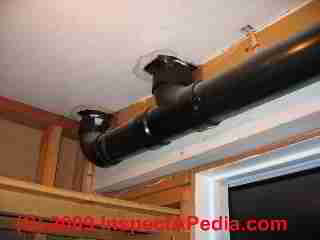 Complete details about black ABS plastic drain piping are
Complete details about black ABS plastic drain piping are
at ABS PLASTIC PIPE. Excerpts are below.
As our black ABS drain piping photo shows (above), some drain line leaks having nothing to do with product defects can occur in this system if the piping is not properly installed.
Field investigations of leak stains (as in our photo) as well as investigations of sewer gas odors have traced these problems to failure to properly clean, prime, and glue the pipe joints during construction.
However, "All Black -hit," defective black ABS plastic waste pipe manufactured in the mid 1980's failed by cracking, as Cranor's photo below illustrates.
"All Black -hit," defective black ABS plastic waste pipe manufactured in the mid 1980's failed by cracking.
The result was litigation and some damage settlements, but currently it is unlikely that a homeowner will find legal relief for newly-discovered ABS drain waste vent piping cracks and failures.
ABS Plastic Drain/Waste/Vent (DWV) pipe failure Brands
ABS drain pipe material failures were reported for pipe made between 1985 and 1988. [1][2][5][6][7] below
- Apache ABS pipe failures: Apache Plastics defective piping was produced due to use of defective raw materials to make ABS DWV between January and May 1985. Not all Apache ABS DWV suffers the cracking failure problem, and less Apache ABS pipe defects are found than among the other manufacturers listed below.
- Centaur ABS pipe: Centaur black ABS pipe was labeled with the company's name and was made between February and August 1985. Decoding for the date in data stamped on Centaur pipe: look at the production code found just past the UPC on the pipe, beginning with an "S"(1985) followed by 5 characters YMDDDP as follows:
- Character 1: Year of manufacture: E=1971, F=1972, G=1973, etc. - an "S" = 1985 and a "T" =- 1986 - key problem years for ABS DWV piping defects.
- Character 2: and Month of manufacture: D=Jan, E=Feb, etc. through O=Dec.
- Characters 3, 4: Day of manufacture (2 characters) encoded as digits 1-0 corresponding to D-M respectively
- Character 5: Production shift or Resin Lot code.
- Character 6: used only for third party sales: Centaur also produced ABS piping for sale under other trade names. In that case Centaur advised that the company printed a "C" suffixed to the end of the product date code.
- Gable ABS pipe failures: Gable plastics defective ABS piping was made during 1985 and 1986 and is very prone to cracking failures and leaks, again due to use of defective plastic raw materials.
- Gable ABS pipe date of manufacture is stamped un-encoded onto the pipe
- Phoenix ABS pipe, successor to Centaur Corp. issued defective, crack-prone ABS piping from January 1986 - October 1986. Phoenix used the same production codes (but the year will indicate it's Phoenix not Centaur).
- Polaris ABS pipe, manufactured defective ABS piping between February 1985 and July 1985. Not all Polaris ABS piping made during this interval suffers the cracking failure, depending on variation in batches of purchased raw material.
- Polaris ABS Pipe Date Encoding: nnnYY where
- nnn = the numeric day of the year (001-365) and YY = the year in digits, such as 10085.
- Spartan ABS pipe
More information: U.S. CPSC Hot Line: 800-638-8270
ABS Plastic Pipe Leak Failures Still Being Discovered
ABS plastic drain and vent line failures are still being discovered, as John Cranor's photo from 2011 illustrates.
Home inspector John Cranor provided the photo at left of a cracked ABS drain line, commenting:
This photo of cracked ABS is damage that I feel has to be related to the defective ABS that was reported years ago. I am in VA and have inspected close to 6000 homes and this was the first I have seen this issue here. I saw at least six spots on the drain pipe in the crawl space that had similar cracking and white crusty residue like shown in photo.
I know there was once a lot of information out there about this issue but now I cannot find hardly anything. The website abspipes.com is now owned by some plumbing contractor and it has no useful information about ABS or its issue.
The seller of the property where I took this photo has some plumber saying there is nothing wrong and that he has never heard of a problem as I described. He claims the white residue is mud and that he could see no crack.
Spotting ABS plastic pipe cracking failures
Although the cracked ABS drain line is quite visible in Mr. Cranor's photo (above), or in some areas where piping is exposed (photo at left) there may not be ready access for visual inspection of all surfaces of all of the plastic ABS drain lines in a building.
Here are some tips that can reduce (not eliminate) the chances of missing faulty black ABS plastic drains:
- For houses built between 1985 and 1988, perhaps extending into 1993 or even later (to allow for use of in-stock older ABS piping), inspectors, building owners, and building buyers should be particularly alert for leaks in ABS black plastic drain, waste or vent piping. As we noted above, for buildings constructed outside of this time window drain lines may have other leaks and defects, regardless of faulty materials themselves.
- Look for visible damage, leaks, leak stains, or loose pipes or fittings that may be moving due to breaks or cracks in the DWV piping. Remember to include inspection of the vent piping system, from on-roof, in the attic, and in other accessible areas. Keep in mind that if you find even one leak there is a high risk that there may be additional hidden leaks as well as future failures and leaks.
- Look for product dates & manufacturer's codes indicating the problem brands of ABS piping, listed above. Experts report defective ABS piping products based on manufacturer's product codes and dates even if no leaks are observed at the time of inspection.
- Look on the under-side of lateral drain line runs through the building for evidence of leak stains on the ABS piping itself - the actual crack may be difficult to spot but leak stains may be more obvious (see the photo above)
- Look for water leak stains on building walls, ceilings, floors below ABS drain pipes on nearby building surfaces
- Look for ABS drain line cracks at the glue-line joint in and look for mixed plastic types (white PVC, black ABS) on older buildings. Cracking ABS failures often occurred close to glued unions. Modern plastic pipe glues can handle and even joint both types of plastics, but at an older installation such as at the home above, where we see mixed plastics we pose the possibility that none of the mixed-type plastic pipe joints may be properly glued. This is not a problem peculiar to defective ABS but the two conditions may be found together.
- Look for evidence of repeated prior repairs that may indicate recurrent cracking and leak failures in the piping system
- Pressure test drain, waste, vent piping systems: for a system that is in doubt or where a hidden leak is suspected (perhaps where there are undiagnosed sewer gas odors), consider pressure testing the DWV piping. Pressure testing can also detect improper pipe joints such as failure to glue the joints properly.
ABS Class Action & Litigation
The prior class action litigation involved five of the six ABS pipe manufacturer's brands listed above: Centaur, Phoenix, Polaris, Gable, and Apache. (Spartan was excluded). We have not found evidence of an class action (June 2012). The attorney involved in prior actions, David Birke-White, indicated (paraphrasing) that defective ABS piping failures are a progressive problem and that piping that had not already failed will do so in the future.[1]
ABS DWV pipe failure references
- See ABS PLASTIC PIPE FAILURES (black plastic drain piping or some water supply piping)
- [1] Mark Cramer, Tampa Florida, provided background information about ABS black plastic drain piping failures, including lists of problem pipe manufacturers, date encoding, and attorney's statements. 2/28/1997. Mr. Cramer is a Florida home inspector and home inspection educator. He is a frequent contributor to InspectApedia.com. Mr. Cramer provided information based on "Inspector's Field Notes"™, William P Ball, Ed., 1996.
- [2] John Cranor [Website: /www.house-whisperer.com ] provided a photograph of failed ABS drain piping used above. Mr. Craynor, an ASHI member and a home inspector (The House Whisperer) is located in Glen Allen, VA 23060. He is also a contributor to InspectApedia.com
- [3] P. Davis, B.E. Tiganis, L.S. Burn, "The effect of photo-oxidative degradation on fracture in ABSpipe resins", Polymer Degradation and Stability,
Volume 84, Issue 2, May 2004, Pages 233–242
Abstract: This work investigates ultraviolet (UV) degradation and its influence on fracture failure in acrylonitrile–butadiene–styrene (ABS) resins.
Preliminary chemiluminescence assessment of coupon specimens indicates that degradation is restricted to the specimen surface, with a relatively rapid depletion of residual stabiliser compared to the bulk of the specimen. Fourier transform infra-red spectral analysis indicates that this surface-specific degradation forms photoproducts with the distortion of absorbance bands (corresponding to the trans CC unsaturation (vinyl) in polybutadiene (PB), and the 1,2-butadiene terminal vinyl C–H band), indicating bond unsaturation.
These changes in chemical structure are attributed to cross-linking and chain scission in the PB phase. It is proposed that surface degradation after UV exposure promotes brittle behaviour and may therefore influence the failure mechanism of ABS pressure pipes under static loading.
The effect of UV exposure in coupon specimens is compared to that of surface notching, and plane-strain fracture toughness tests are used to obtain an empirical relationship between exposure time and “equivalent” notch depth. By assuming that this relationship is independent of specimen geometry (i.e. degradation is restricted to the surface), a methodology for estimating the lifetime of UV-exposed ABSpipes is proposed.
An analysis of DN100 Class 15 ABSpipes predicts that a transition to brittle fracture failure occurs after 137 years. However, it is recommended that the influence of pipe wall thickness on degradation kinetics be quantified. - [2] J. P. Lu, P. Davis, L. S. Burn, "Lifetime prediction for ABS pipes subjected to combined pressure and deflection loading", Polymer Engineering & Science
Volume 43, Issue 2, pages 444–462, February 2003,
Abstract As part of an investigation into the performance of acrylonitrile-butadiene-styrene (ABS) systems for water transportation, this paper presents a method for predicting the service lifetimes of buried pipes under in-service loading conditions. A linear fracture mechanics approach was used to analyze brittle failure initiating from adventitious flaws located at the bore surface of pipe.
Failure criteria were determined using the time-dependent, quasistatic, plane strain fracture toughness of the ABS material, combined with empirical parameters that describe slow, steady crack growth. The expected operating conditions of a buried pipe were then separated into static loading contributions from internal pressure, diametrical deflection and residual stress.
Idealized stress intensity factors associated with mode-I crack opening under each of these components were determined using a finite element analysis and superposed to describe the general case in service. The computed nett stress intensity factor was then combined with the previously determined fracture toughness and slow crack growth data in an algorithm to simulate incremental radial crack growth from the pipe bore.
Predicted failure times compared well with an experimental model of expected operating conditions, which combined hydrostatic pressure and parallel-plate deflection loading of an internally notched pipe. The prediction method was also used to identify the factors that control the lifetime of a pipe in service. The influence of material visco-elasticity was investigated by simulating variations in fracture toughness and slow crack growth resistance.
It was proposed that, in practice, these variations are governed by opposing changes in visco-elasticity. The effect of changing diametrical deflection and residual stress distribution were also simulated, allowing recommendations on pipe manufacture and installation conditions to be made. - [4] Lieff, Cabraser, Heimann & Bernstein, Attorneys at Law, "Lieff Cabraser represented plaintiffs who alleged that certain ABS pipe contained plastic resin that caused it to crack and leak."
http://www.lieffcabraser.com/ - [5] Bill Ball, "ABS Failure Video", Bill Ball Enterprises, 3104 O St., Sacramento CA 96186, Tel: 800-309-HOME.
- [6] Note: the previous "Official website for the class action suit against ABS manufacturers" , with the official claim form and descriptive information: http://www.abspipes.com/ is no longer functional.
- [7] Redwood Kardon, "ABS DWV Pipe: reported defects", 1996, CodeCheck.com
Pex Tubing: Cross-Linked Polyethylene (PEX)

Complete details about PEX are at PEX PIPING INFORMATION, Excerpts are below.
PEX and PB plastic pipe are used for water supply in buildings use mechanical fittings (crimp and compression type) and we have found some installers using PEX tubing in low temperature heating applications (see below).
PEX piping is also referred to as "cross-linked polyethylene" piping or just "PEX".
Our photo (left) illustrates PEX water supply piping being installed in a New York home.
Installing both building water supply piping and heating supply piping (and radiant heating) can be significantly faster using PEX tubing because of its ability to bend around turns, avoiding some elbows, 45's and other fittings.
PEX piping is used in both hot and cold water applications (see the blue and red colors below). By convention the builder uses blue PEX for cold water and red PEX for hot water supply piping lines.
Watch out: however PEX tubing is sold in other colors too, including white PEX tubing and black PEX tubing.
Generally you will find PEX piping or tubing marked with the nominal pipe size, wall thickness, and pressure rating and other information (see the illustration just below).
Temperature and pressure ratings for PEX, according to Zurn Manufacturing's engineering specifications is 160 PSI at 73°F, 100 PSI at 180°F, and 80 PSI at 200°F.

Illustration of PEX tubing markings - courtesy Zurn Manufacturing (permission requested 12/2010).
[Click any image or table to see an enlarged, detailed version.]
When installing PEX piping, care must be taken that the pipe does not contact heating ducts. If the pipe freezes, it is less likely to burst than and copper piping. Also, most types of plastic water pipe tend to sag and should be well supported by hangers.
Watch out: PEX plastic water piping should not be installed outdoors or exposed to sunlight for long periods. The red and blue PEX piping shown below (right) were delivering hot and cold water in a newly-constructed home. The larger black ABS plastic pipe is probably a drain line.
Watch out: do not use plastic piping nor any other type of piping in applications for which it was not intended, or the result could be dangerous. For example, do not use PEX tubing for LP or natural gas piping
Examples & Photographs of the various types of PEX fittings and the special tools used include:
Photo below, white PEX tubing manufactured by Zurn, installed using crimp type PEX fittings in a Haddonfield New Jersey home). The copper crimp rings are used with most PEX connectors.
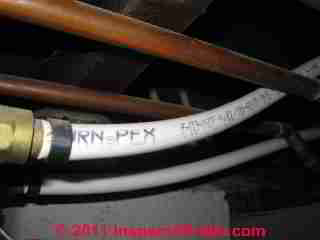
PB Pipe: Polybutylene Plumbing Plastic Pipe Use, Installation Specs, Failures, Leaks, Claims, Settlements
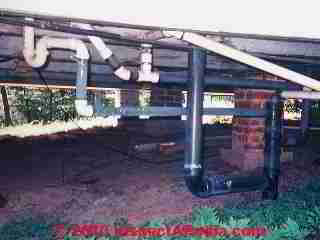
Complete details are at PB POLYBUTYLENE (PB) PIPE. Excerpts are below.
Thumbnail: Polybutylene (Polybutylene) Plumbing (plastic pipes): gray plastic water supply piping cracked, leaked, and resulted in a class action and settlement.
PB or Polybutylene pipe material (photo at left, center horizontal piping) is gray plastic water supply piping that racked, leaked, and its early use resulted in a class action and settlement.
In 1995 a $950 million class action settlement, Cox v. Shell Oil Company, provided relief for damage due to leaks in Polybutylene plumbing (PB Plumbing) within certain age constraints. Periodic notices were to be provided to homeowners over a 12-year period (ending ca. 2007) as follows:
Owners who purchased a house, mobile home, or other structure in the United States after August 21, 1995, provided that the structure contained polybutylene piping with plastic or metal insert fittings when they purchased it, are included in the class. These individuals may have been entitled to free replacement of their plumbing if it leaked previously or in the future.
The Polybutylene Pipe Settlement case is now closed. Homeowners whose structures still contain problematic versions of PB plumbing may nevertheless find that their building or mobile home is damaged by leaks and needs repairs. However there is no longer relief provided under the class action suit.
By 2010 it would be uncommon to find problematic plastic piping in buildings as we expect that where leaks were a problem, they have in many if not most installations, been discovered and repaired by now.
However home inspectors and home buyers as well as building maintenance staff need to be alert for discovery of older problematic or leaky plastic piping in buildings.
When we see several types (colors) of plastic piping mixed together, especially on older renovation or handyman plumbing jobs we worry that amateur work may have omitted use of the proper pipe glues and sealants.
But the majority of leak problems with polybutylene supply lines involve failure of plastic fittings. Fitting failure may lead to the need for system replacement.
This type of fitting was commonly used from the late 1970s until the late 1980s. Copper fittings were used in most installations from the late 1980s until the late 1990s. Failure of copper fittings is rare.
PPR Piping: Polypropylene Random Copolymer
PPR pipe is a rigid pipe made from Polypropylene Random Copolymer plastic, manufactured using a continuous extrusion process.
With its green or white exterior and a white or gray internal core, PPR is used in both cold and hot water piping systems, in heating system piping and in a wide range of other applications.
Complete details about PPR plastic piping are
PVC Piping: CPVC Chlorinated Polyvinyl Chloride Water Piping in buildings
Complete details are at CPVC & PVC PLASTIC PIPING. Excerpts are below.
Chlorinated polyvinyl chloride (CPVC) pipe is not as flexible as PB or PEX and the fittings are solvent welded (glued) rather than press-on. This pipe is likely to split if freezing occurs. CPVC pipe is suitable for use on both hot and cold water lines.
Our photo (left) illustrates Royal brand PVC sewer piping being installed at a New York Home. Photo courtesy Galow Homes.
Watch out: PVC polyvinyl chloride pipe produced by JM Eagle Corp. is reported to be defective, leaking or breaking as early as in the first year after installation. Details are at PLASTIC PIPE LEAK CAUSES.
See WATER HEATER DEBRIS FLUSH for an example of a deteriorated plastic water heater dip tube debris that clogged the building water supply piping, faucets, fixtures.
PVC is Poly(Vinyl) Chloride, CPVC is Chlorinated Poly(Vinyl) Chloride.
PVC and ABS (Acrylonitrile-Butadiene-Styrene) pipe are normally used for drain, waste and vent (DWV) systems.
CPVC is used for water distribution systems. It is important to choose the correct solvent cement or pipe glue based on the type of plastic pipe being used.
...
Reader Comments, Questions & Answers About The Article Above
Below you will find questions and answers previously posted on this page at its page bottom reader comment box.
Reader Q&A - also see RECOMMENDED ARTICLES & FAQs
Help Inspecting & Identifying Plastic Pipe Types & Defects
Above: Gray PB Polybutylene piping and corroded leaky crimp connectors in a home inspected by BnB Home Inspections in 2019, photo courtesy of BnB Home Inspections.
Additional photographs pf PB pipe and pipe leaks are given with more detail
These photos were taken from a 1989 Manufactured home where the inspector observed Vanguard markings on the piping as well, but this was not a Vanguard Manabloc set-up - see the photo above.
[Click to enlarge any image]
- Brad Barbour, BNB Home Inspection Services, Residential Home Inspector Wa. Lic. #1226, Structural Pest Inspector W.S.D.A. Lic. #87852, International Assoc. of Home Inspectors-- Certified Inspector #15011605, Website: bnbhomeinspections.com Tel: (360) 724-8180 - Whatcom, Skagit, Island & Northern Snohomish Counties in Washington State
Watch out: when relying on the color of plastic pipe to identify its type. Identifying PEX by depending on color (red or blue) canalso trick us as we also may encounter white PEX water supply piping (e.g. Zurn PEX Non-Barrier Tubing & Zurn Q3PC100X or white PEX from Wisbro) and also gray PEX water supply tubing such as the snapshot I'll post below (from freshwatersystems.com) and also ViegaPEX Barrier Tubing that is black!
Above: this tubing is PEX not Polybutylene. Most plastic piping products are stamped with the piping type, the manufacturer, and other information.
ABS pipes are discussed at ABS PLASTIC PIPE
PB or PolyButylene piping is discussed separately at PB POLYBUTYLENE (PB) PIPES
PEX piping is discussed separately at PEX PIPING INFORMATION
Technical notes
1. excerpting from Zurn
Zurn PEX tubing is produced usitng the silane methos of cross-linking. It is used in residential and commercial applications for cold water service, hot and cold potable water, fire protection, underground fluid distribution and water distribution to manifolds, hydronic coils etc. It may also be used in radiant heating systems. Designed to continuously circulate hot water at 140 degrees ferenheit. 160 PSI @ 73 degrees, 100PSI @ 180 degrees. - GlobalIndustrial.com
Contact Zurn: Website: www.zurn.com/innovation-efficiency/pex
2. Excerpt from ViegaPEX
ViegaPEX Barrier tubing is produced from cross-linkable, high density polyethylene resin. ViegaPEX Barrier includes four layers. The first layer is cross-linked, high density polyethylene. The second layer is an adhesive for the third layer, the ethylene vinyl alcohol layer (EVOH oxygen barrier). The fourth layer is another thin layer of polyethylene, applied on the outside to protect the EVOH layer from damage. EVOH is highly resistant to the passage of oxygen.
ViegaPEX Barrier tubing is recommended for hydronic radiant heating, cooling and snow melting systems using water or a water/glycol mix as the heat transfer media. Tubing may be installed in concrete, gypsum based lightweight concrete, sand, asphalt (in accordance with special guidelines) in or under wood flooring or behind wallboard or plaster. ViegaPEX Barrier may also be used as transfer lines for baseboard heating systems with a maximum operating temperature of 200°F @ 80 psi.
Contact Viega: Website: https://www.viega.us/ Tel: 800-976-9819
Reader Question: Rat-Attack? Do Rodents Attack Plastic Tubing or Piping? Does the tubing color make a difference in rodent resistance?
This might seem a strange question but we have blue plastic used for the connection from our gas tanks to our cooker. We have just had it serviced and have been advised that it should be yellow plastic. We have had the blue plastic for a lot of years and have been told it must be changed because the yellow tubing is not susceptible to vermin.
Since we have never had a problem with vermin and the blue tubing – I was wondering how true this is and why do the vermin not like the yellow tubing. It would be good to get some advice before we start doing unnecessary work. Thank you for your help - D.M.
Reply: Yes, No, and maybe
We have indeed had reports of rodents chewing on plastic piping of various types, colors, brands, and application (water piping and gas piping for example). And rodents will gnaw on other plastic piping too, not just PEX.
You didn't say exactly what kind of plastic piping you are using nor its brand - that information would let us check with the manufacturer for recommendations about rodent proofing the piping. Certainly we don't want a rodent-chewed hole in any piping but in gas piping it would be particularly dangerous.
I am doubtful that changing from one color piping to another would make much difference in rodent resistance if the piping brand and material is the same; but if the color change includes a change of material, the new material might be more rodent resistance.
In a New York installation I have seen yellow plastic-covered flexible copper tubing used for both gas piping (not through walls and ceilings or hidden locations) and heating oil piping. A mouse that chewed the outer plastic cover would most likely not get through the copper, but you'd lose the protective coating at that spot. At that same installation, we used threaded black pipe for gas piping where it runs through hidden locations such as ceilings and walls.
If your pipe damage is occurring indoors you need the services of a pest control expert - an "exterminator" too.
If you can send along details about the pipe type and brand we'll research further. See the CONTACT link on our pages.
...
Reader Comments, Questions & Answers About The Article Above
Below you will find questions and answers previously posted on this page at its page bottom reader comment box.
Reader Q&A - also see RECOMMENDED ARTICLES & FAQs
On 2016-01-03 by (mod) -
Charles:
I would cut back the Poly-B pipe (polybutylene pipe) to a location where I could fit a crimping tool, then install a Tee, Wye, or whatever stainless fitting you need to connect to both types of material. Be sure to also
read PEX BRASS CONNECTOR LEAKS
On 2016-01-01 by charles
What can I use to connect ply B (PB Piping) pipe to pex where there is no room for a crimping tool?
On 2015-02-10 by (mod) -
I think you are citing pipe that complied with this ASTM standard
ASTM D2662-96a
Standard Specification for Polybutylene (PB) Plastic Pipe (SIDR-PR) Based on Controlled Inside Diameter (Withdrawn 2003)
On 2015-02-10 by Linda
Trying to identify this blue water line with the numbers AST D2662, what kind is this? Is this polybutylene?
On 2014-05-04 by Anonymous
what are the basic principles of pipe fittings?
Question:
(June 15, 2014) Anonymous said:
is there any on going litigation or settlement remedies available to a homeowner with repetitive interior bursting of plastic water lines in the interior of the home, home built in 1998 in Murphreesboro Tn.
Reply:
Anon I think we need to start by identifying the type of piping involved. Then you can find its status in the links in the article above.
Question:
(Oct 1, 2014) Anonymous said:
Linda in Cape Coral Florida. I just had some major water leaks and Found out that the water pipes were defective. Can I still get help with this.
(Dec 4, 2014) Don in central fl said:
I have a 2006 fleet wood home and I just came home to my home filled with water. The problem was the white push button type shut off valve under the sink. Is there anything I can do to get help with all the repairs? My insurance company said they won't cover the damage. I also found another one that is leaking in the wall that supplies the washing machine.
Reply:
Don, ugh! Sorry you got flooded.
Check over your insurance policy with an attorney or an insurance adjuster to be sure you are being treats fairly.
See The article giving advice at FLOOD DAMAGE ASSESSMENT SAFETY &CLEANUP
Found in the ARTICLE INDEX near the end of this page. There you will find advice on minimizing damage, safety, etc.
Question:
Rebekah said:
We live in Colorado with decently cold winters. We have orangeburd pipe that is starting to squish into an oval pipe and the tree roots are begining to penetrate. Which type of pipe is better, will last longer, for main sewer line replacement? PVC, Schedule 40, HDPE,any others you could recommend?
Reply:
In my OPINION Schedule 40 PVC plastic sewer piping is quite durable (quoting from Harvel's specifications: Produced rigid polyvinyl chloride (PVC) compound, Type I Grade I, with a Cell Classification of 12454 as defined in ASTM D1784, trade name designation H707 PVC ... and meeting the requirements of ASTM D1785 and ASTM D2665.)
But keep in mind that installation details are important: proper trench excavation to compacted soil, bedding pipe on and in sand, avoiding backfill with sharp rocks &c.
If piping is to be buried where it may be driven-over by vehicles or heavy equipment, you might even consider Schedule 80 pipe for that location or pipe run.
Question: is PEX the same as Kitec® ?
Is PEX the same as Kitec? How does one tell distinguish between Kitec and PEX? - see PEX PIPING INFORMATION
Plastic vs Copper pipe in buildings, which is better?
This discussion is now found at PLASTIC vs. COPPER PIPES in BUILDINGS
Question: Pex vs. Copper Water Supply Piping - which should I use?
We moved this discussion to its own article found at PLASTIC vs. COPPER PIPES in BUILDINGS
PB Pipe: Polybutylene Pipe Failures, Claims, Litigation, Contact Information
This discussion is now at PB piping failures, claims, and litigation. -DF
Plumb-PEX Plumbing System Class Action Settlement - PEX piping leaks
This topic is now found at PLUMB-PEX SETTLEMENT discussed as a section of PLASTIC PIPE LEAK CAUSES
...
Continue reading at ABS PLASTIC PIPE or select a topic from the closely-related articles below, or see the complete ARTICLE INDEX.
Or see these
Recommended Articles
- PIPING in BUILDINGS, CLOGS, LEAKS, TYPES - home
- PLASTIC PIPE LEAK CAUSES
- PLASTIC PIPING ABS CPVC PB PEX PPR PVC - home
- ABS PLASTIC PIPE
- CPVC & PVC PLASTIC PIPING
- JM Eagle® DEFECTIVE PVC PolyVinyl Chloride PIPING LAWSUIT
- Kitek® PLASTIC PIPELEAKS & LAWSUIT
- PB POLYBUTYLENE (PB) PIPES
- PB PIPE FAILURE CLAIMS
- PEX PIPING INFORMATION
- PEX vs. COPPER PIPING, SAFETY
- PEX BRASS CONNECTOR LEAKS
- PEX CONNECTIONS to WATER HEATERS
- PLASTIC PIPE LEAK CAUSES
- PLASTIC vs. COPPER PIPES in BUILDINGS
- PPR PIPING GUIDE
- PVC & CPVC PIPE INSTALLATION STEPS
- PVC & CPVC PIPE GLUING SET & CURE TIMES
- PLASTIC PIPE PRESSURE LIMITS
- PLASTIC PLEXVENT ULTRAVENT RECALL
Suggested citation for this web page
PLASTIC PIPING ABS CPVC PB PEX PPR PVC at InspectApedia.com - online encyclopedia of building & environmental inspection, testing, diagnosis, repair, & problem prevention advice.
Or see this
INDEX to RELATED ARTICLES: ARTICLE INDEX to PLUMBING SYSTEMS
Or use the SEARCH BOX found below to Ask a Question or Search InspectApedia
Ask a Question or Search InspectApedia
Try the search box just below, or if you prefer, post a question or comment in the Comments box below and we will respond promptly.
Search the InspectApedia website
Note: appearance of your Comment below may be delayed: if your comment contains an image, photograph, web link, or text that looks to the software as if it might be a web link, your posting will appear after it has been approved by a moderator. Apologies for the delay.
Only one image can be added per comment but you can post as many comments, and therefore images, as you like.
You will not receive a notification when a response to your question has been posted.
Please bookmark this page to make it easy for you to check back for our response.
IF above you see "Comment Form is loading comments..." then COMMENT BOX - countable.ca / bawkbox.com IS NOT WORKING.
In any case you are welcome to send an email directly to us at InspectApedia.com at editor@inspectApedia.com
We'll reply to you directly. Please help us help you by noting, in your email, the URL of the InspectApedia page where you wanted to comment.
Citations & References
In addition to any citations in the article above, a full list is available on request.
- Eric Galow, Galow Homes, Lagrangeville, NY. Mr. Galow can be reached by email: ericgalow@gmail.com or by telephone: 914-474-6613. Mr. Galow specializes in residential construction including both new homes and repairs, renovations, and additions.
- [3] PB (polybutylene with mechanical fittings) Piping leaks: especially in mobile homes and in the U.S. South, for example trailers and double-wides throughout Florida that were piped with this material - per M Cramer. See "Polybutylene Piping: Time Bomb?" Daniel Friedman, Journal of Light Construction, August 1996 [Technical Q&A] .
- [4] ABS Plastic Pipe: "All Black -hit," defective black ABS plastic waste pipe manufactured in the mid 1980's failed by cracking. Additional information: www.abspipes.com
- [5] Polybutylene Plumbing (plastic pipes): gray plastic water supply piping cracked, leaked, and resulted in a class action and settlement.
- Our recommended books about building & mechanical systems design, inspection, problem diagnosis, and repair, and about indoor environment and IAQ testing, diagnosis, and cleanup are at the InspectAPedia Bookstore. Also see our Book Reviews - InspectAPedia.
- In addition to citations & references found in this article, see the research citations given at the end of the related articles found at our suggested
CONTINUE READING or RECOMMENDED ARTICLES.
- Carson, Dunlop & Associates Ltd., 120 Carlton Street Suite 407, Toronto ON M5A 4K2. Tel: (416) 964-9415 1-800-268-7070 Email: info@carsondunlop.com. Alan Carson is a past president of ASHI, the American Society of Home Inspectors.
Thanks to Alan Carson and Bob Dunlop, for permission for InspectAPedia to use text excerpts from The HOME REFERENCE BOOK - the Encyclopedia of Homes and to use illustrations from The ILLUSTRATED HOME .
Carson Dunlop Associates provides extensive home inspection education and report writing material. In gratitude we provide links to tsome Carson Dunlop Associates products and services.



